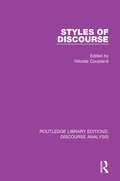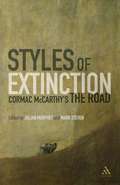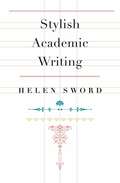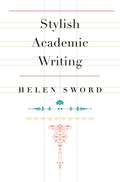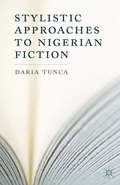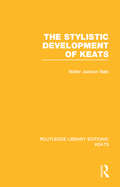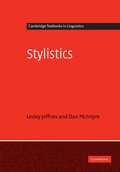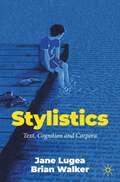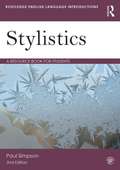- Table View
- List View
Styles of Discourse (RLE: Discourse Analysis)
by Nikolas CouplandFirst published in 1988, this book focuses on diversity and discourse, and collects contemporaneous research across a wide range of topics including: description, polemic, narrative analysis, DJ talk, philosophical history, conversation, children’s books and nuclear deterrence. The essays demonstrate analyses of discourse in the service of stylistic inquiry, exploring relationships of text and context. This reflects the overall argument that discourse analyses aiming to represent diversity of social context will necessarily approach the task selectively, since all dimensions are of potential relevance to any and every communicative manifestation. Some of contextual dimensions that are addressed include: interpersonal, socio-structural, modal, ideological, and pragmatic.
Styles of Discourse (RLE: Discourse Analysis)
by Nikolas CouplandFirst published in 1988, this book focuses on diversity and discourse, and collects contemporaneous research across a wide range of topics including: description, polemic, narrative analysis, DJ talk, philosophical history, conversation, children’s books and nuclear deterrence. The essays demonstrate analyses of discourse in the service of stylistic inquiry, exploring relationships of text and context. This reflects the overall argument that discourse analyses aiming to represent diversity of social context will necessarily approach the task selectively, since all dimensions are of potential relevance to any and every communicative manifestation. Some of contextual dimensions that are addressed include: interpersonal, socio-structural, modal, ideological, and pragmatic.
Styles of Enlightenment: Taste, Politics, and Authorship in Eighteenth-Century France (Parallax: Re-visions of Culture and Society)
by Elena RussoStyles of Enlightenment argues that alongside its democratic ideals and its efforts to create a unified public sphere, the Enlightenment also displayed a tendency to erect rigid barriers when it came to matters of style and artistic expression. The French philosophes tackled the issue of the hierarchy of genres with surprising inflexibility, and they looked down on those forms of art that they saw as commercial, popular, and merely entertaining. They were convinced that the standard of taste was too important a matter to be left to the whims of the public and the vagaries of the marketplace: aesthetic judgment ought to belong to a few, enlightened minds who would then pass it on to the masses.Through readings of fictions, essays, memoirs, eulogies, and theatrical works by Fénelon, Bouhours, Marivaux, Montesquieu, Voltaire, Diderot, Rousseau, Mercier, Thomas, and others, Styles of Enlightenment traces the stages of a confrontation between the virile philosophe and the effeminate worldly writer, "good" and "bad" taste, high art and frivolous entertainment, state patronage and the privately sponsored marketplace, the academic eulogy and worldly conversation. It teases out the finer points of division on the public battlefields of literature and politics and the new world of contesting sexual economies.
Styles of Extinction: Cormac McCarthy's The Road
by Julian Murphet Mark StevenStyles of Extinction: Cormac McCarthy's The Road brings together several leading literary scholars, one major philosopher, as well as a handful of emerging critical voices, all of whom deploy their own specialist methods in order to think through this bestselling, Zeitgeist-defining event of contemporary literature. There are two dominant modes of analysis gathered here: the first, performed by Julian Murphet, Paul Sheehan, and Mark Steven, is to locate the novel within its political, spiritual, and economic climates; the second, whose exponents include Paul Patton, Sean Pryor, Chris Danta, and Grace Hellyer, deals with the formal dimensions of McCarthy's characteristically brilliant prose in relation to its sparse narrative. By coupling historically sensitive analysis with incisive formal criticism, the contributors not only account for the matchless form of this exemplary novel; they also suggest that The Road has something unique to disclose about the world we inhabit.
Styles of Extinction: Cormac McCarthy's The Road
by Julian Murphet Mark StevenStyles of Extinction: Cormac McCarthy's The Road brings together several leading literary scholars, one major philosopher, as well as a handful of emerging critical voices, all of whom deploy their own specialist methods in order to think through this bestselling, Zeitgeist-defining event of contemporary literature. There are two dominant modes of analysis gathered here: the first, performed by Julian Murphet, Paul Sheehan, and Mark Steven, is to locate the novel within its political, spiritual, and economic climates; the second, whose exponents include Paul Patton, Sean Pryor, Chris Danta, and Grace Hellyer, deals with the formal dimensions of McCarthy's characteristically brilliant prose in relation to its sparse narrative. By coupling historically sensitive analysis with incisive formal criticism, the contributors not only account for the matchless form of this exemplary novel; they also suggest that The Road has something unique to disclose about the world we inhabit.
Styles of Seriousness
by Steven ConnorBeing serious demands serious kinds of work. In Styles of Seriousness, Steven Connor reflects on the surprisingly various ways in which a sense of the serious is made and maintained, revealing that while seriousness is the most powerful feeling, it is also the most poignantly indeterminate, perhaps because of the impossibility of being completely serious. In colloquy with philosophers such as Aristotle, Nietzsche, James, Sartre, Austin, Agamben and Sloterdijk, and writers like Shakespeare, Byron, Auden and Orwell, Connor considers the linguistic and ritual behaviors associated with different modes of seriousness: importance; intention, or ways of really "meaning things;" sincerity; solemnity; urgency; regret; warning; and ordeal. The central claim of the book is human beings are capable of taking things seriously in a way that nonhuman animals are not, for the unexpected reason that human beings are so much more versatile than most animals at not being completely serious. One always, in fact, has a choice about whether or not to take seriously something that is supposed to be so. As a consequence, seriousness depends on different kinds of formalization or stylized practice. Styles of seriousness matter, Connor shows, because human beings are incapable of simply and spontaneously existing. Being a human means having to take seriously one's style of being.
Styles of Seriousness
by Steven ConnorBeing serious demands serious kinds of work. In Styles of Seriousness, Steven Connor reflects on the surprisingly various ways in which a sense of the serious is made and maintained, revealing that while seriousness is the most powerful feeling, it is also the most poignantly indeterminate, perhaps because of the impossibility of being completely serious. In colloquy with philosophers such as Aristotle, Nietzsche, James, Sartre, Austin, Agamben and Sloterdijk, and writers like Shakespeare, Byron, Auden and Orwell, Connor considers the linguistic and ritual behaviors associated with different modes of seriousness: importance; intention, or ways of really "meaning things;" sincerity; solemnity; urgency; regret; warning; and ordeal. The central claim of the book is human beings are capable of taking things seriously in a way that nonhuman animals are not, for the unexpected reason that human beings are so much more versatile than most animals at not being completely serious. One always, in fact, has a choice about whether or not to take seriously something that is supposed to be so. As a consequence, seriousness depends on different kinds of formalization or stylized practice. Styles of seriousness matter, Connor shows, because human beings are incapable of simply and spontaneously existing. Being a human means having to take seriously one's style of being.
Styling Your Writing: Mixing and Matching Academic Writing Techniques to Create Something Uniquely You
by Jen McConnelThis text helps developing writers in the academy and beyond think through their writing process and develop strategies for styling their writing to meet the demands of a wide range of goals. The book imagines writing as an assortment of "outfits"— bundles of styles and strategies through which one approaches a writing purpose, such as writing focused on experimentation and growth or writing focused on a professional task. By assessing the outfits writers feel most and least confident in, and examining how to be more at home in the outfits that matter to them, this book helps students develop both specific skills and their overall identity as writers. Readers are guided through before-, during-, and after-writing strategies and techniques, including: freewriting, outlining, visual planning, and composing in multimodal forms. Readers are also introduced to the importance of setting clear writing goals and sharing their work in a variety of ways, both in preparation for classroom success through peer review and writing center visits, and beyond the classroom in virtual and in-person spaces. This book serves as a core or supplemental text for writing courses at the undergraduate, graduate, or high school level, or as a writing guide for individual readers.
Styling Your Writing: Mixing and Matching Academic Writing Techniques to Create Something Uniquely You
by Jen McConnelThis text helps developing writers in the academy and beyond think through their writing process and develop strategies for styling their writing to meet the demands of a wide range of goals. The book imagines writing as an assortment of "outfits"— bundles of styles and strategies through which one approaches a writing purpose, such as writing focused on experimentation and growth or writing focused on a professional task. By assessing the outfits writers feel most and least confident in, and examining how to be more at home in the outfits that matter to them, this book helps students develop both specific skills and their overall identity as writers. Readers are guided through before-, during-, and after-writing strategies and techniques, including: freewriting, outlining, visual planning, and composing in multimodal forms. Readers are also introduced to the importance of setting clear writing goals and sharing their work in a variety of ways, both in preparation for classroom success through peer review and writing center visits, and beyond the classroom in virtual and in-person spaces. This book serves as a core or supplemental text for writing courses at the undergraduate, graduate, or high school level, or as a writing guide for individual readers.
Stylish Academic Writing
by Helen SwordElegant ideas deserve elegant expression. Sword dispels the myth that you can’t get published without writing wordy, impersonal prose. For scholars frustrated with disciplinary conventions or eager to write for a larger audience, here are imaginative, practical, witty pointers that show how to make articles and books enjoyable to read—and to write.
Stylish Academic Writing
by Helen SwordElegant data and ideas deserve elegant expression, argues Helen Sword in this lively guide to academic writing. For scholars frustrated with disciplinary conventions, and for specialists who want to write for a larger audience but are unsure where to begin, here are imaginative, practical, witty pointers that show how to make articles and books a pleasure to read—and to write.Dispelling the myth that you cannot get published without writing wordy, impersonal prose, Sword shows how much journal editors and readers welcome work that avoids excessive jargon and abstraction. Sword’s analysis of more than a thousand peer-reviewed articles across a wide range of fields documents a startling gap between how academics typically describe good writing and the turgid prose they regularly produce.Stylish Academic Writing showcases a range of scholars from the sciences, humanities, and social sciences who write with vividness and panache. Individual chapters take up specific elements of style, such as titles and headings, chapter openings, and structure, and close with examples of transferable techniques that any writer can master.
Stylistic Approaches to Nigerian Fiction
by D. TuncaDrawing on the discipline of stylistics, this book introduces a series of methodological tools and applies them to works by well-known Nigerian writers, including Abani, Adichie and Okri. In doing so, it demonstrates how attention to form fosters understanding of content in their work, as well as in African and postcolonial literatures more widely.
Stylistic Approaches to Pop Culture (Routledge Studies in Rhetoric and Stylistics)
by Christoph SchubertThis collection showcases the unique potential of stylistic approaches for better understanding the multifaceted nature of pop culture discourse. As its point of departure, the book takes the notion of pop culture as a phenomenon characterized by the interaction of linguistic signs with other modes such as imagery and music to examine a diverse range of genres through the lens of stylistics. Each section is grouped around thematic lines, looking at literary fiction, telecinematic discourse, music and lyrics, as well as cartoons and video games. The 12 chapters analyze different forms of media through five central strands of stylistics, from sociolinguistic, pragmatic, cognitive, multimodal, to corpus-based approaches. In drawing on these various stylistic frameworks and applying them across genres and modes, the contributions offer readers deeper insights into the role of scripted and performed language in social representation and identity construction, thereby highlighting the affordances of stylistics research in studying pop cultural texts. This volume is of particular interest to students and researchers in stylistics, linguistics, literary studies, media studies, and cultural studies.
Stylistic Approaches to Pop Culture (Routledge Studies in Rhetoric and Stylistics)
by Christoph Schubert Valentin WernerThis collection showcases the unique potential of stylistic approaches for better understanding the multifaceted nature of pop culture discourse. As its point of departure, the book takes the notion of pop culture as a phenomenon characterized by the interaction of linguistic signs with other modes such as imagery and music to examine a diverse range of genres through the lens of stylistics. Each section is grouped around thematic lines, looking at literary fiction, telecinematic discourse, music and lyrics, as well as cartoons and video games. The 12 chapters analyze different forms of media through five central strands of stylistics, from sociolinguistic, pragmatic, cognitive, multimodal, to corpus-based approaches. In drawing on these various stylistic frameworks and applying them across genres and modes, the contributions offer readers deeper insights into the role of scripted and performed language in social representation and identity construction, thereby highlighting the affordances of stylistics research in studying pop cultural texts. This volume is of particular interest to students and researchers in stylistics, linguistics, literary studies, media studies, and cultural studies.
Stylistic Approaches to Translation (Translation Theories Explored)
by Jean Boase-BeierThe concept of style is central to our understanding and construction of texts. But how do translators take style into account in reading the source text and in creating a target text? This book attempts to bring some coherence to a highly interdisciplinary area of translation studies, situating different views and approaches to style within general trends in linguistics and literary criticism and assessing their place in translation studies itself. Some of the issues addressed are the link between style and meaning, the interpretation of stylistic clues in the text, the difference between literary and non-literary texts, and more practical questions about the recreation of stylistic effects. These various trends, approaches and issues are brought together in a consideration of the most recent cognitive views of style, which see it as essentially a reflection of mind. Underlying the book is the notion that knowledge of theory can affect the way we translate. Far from being prescriptive, theories which describe what we know in a general sense can become part of what an individual translator knows, thus opening the way for greater awareness and also greater creativity in the act of translation. Throughout the discussion, the book considers how insights into the nature and importance of style might affect the actual translation of literary and non-literary texts.
Stylistic Approaches to Translation (Translation Theories Explored #Vol. 10)
by Jean Boase-BeierThe concept of style is central to our understanding and construction of texts. But how do translators take style into account in reading the source text and in creating a target text? This book attempts to bring some coherence to a highly interdisciplinary area of translation studies, situating different views and approaches to style within general trends in linguistics and literary criticism and assessing their place in translation studies itself. Some of the issues addressed are the link between style and meaning, the interpretation of stylistic clues in the text, the difference between literary and non-literary texts, and more practical questions about the recreation of stylistic effects. These various trends, approaches and issues are brought together in a consideration of the most recent cognitive views of style, which see it as essentially a reflection of mind. Underlying the book is the notion that knowledge of theory can affect the way we translate. Far from being prescriptive, theories which describe what we know in a general sense can become part of what an individual translator knows, thus opening the way for greater awareness and also greater creativity in the act of translation. Throughout the discussion, the book considers how insights into the nature and importance of style might affect the actual translation of literary and non-literary texts.
The Stylistic Development of Keats (Routledge Library Editions: Keats)
by Walter Jackson BateThis study, first published in 1945, gives a precise description of the unfolding of a great poet’s craftsmanship and suggests alignments of the technical progression with the changes of the mind. Metrical analysis is given in order to throw light on Keats’ general stylistic development using the simplest terminology and in a traditional manner. Earlier English prosodic writings are referred to throughout in order to place the style and development in the context of the period. Arranged chronologically, each chapter looks at a particular work or group of works drawing together evidence about Keats’ poetic direction. This classic work from a well-known Keats scholar is an important enlightening contribution within the extensive study of Keats’ poetry and letters.
The Stylistic Development of Keats (Routledge Library Editions: Keats)
by Walter Jackson BateThis study, first published in 1945, gives a precise description of the unfolding of a great poet’s craftsmanship and suggests alignments of the technical progression with the changes of the mind. Metrical analysis is given in order to throw light on Keats’ general stylistic development using the simplest terminology and in a traditional manner. Earlier English prosodic writings are referred to throughout in order to place the style and development in the context of the period. Arranged chronologically, each chapter looks at a particular work or group of works drawing together evidence about Keats’ poetic direction. This classic work from a well-known Keats scholar is an important enlightening contribution within the extensive study of Keats’ poetry and letters.
Stylistics: A Practical Coursebook
by Jonathan Hope Laura WrightUsing a wide range of twentieth-century literary prose Laura Wright and Jonathan Hope provide an `interactive' introduction to the techniques of stylistic analysis. Divided up into five sections; the noun phrase, the verb phrase, the clause, text structure and vocabulary, the book also provides an introduction to the basics of descriptive grammar for beginning students. * Presumes no prior linguistic knowledge * Provides a comprehensive glossary of terms * Adaptable: designed to be used in a variety of classroom contexts * Introduces students to an enormous range of 20th century literature from James Joyce to Roddy Doyle A practical coursebook rather than a survey account of stylistics as a discipline, the book provides over forty opportunities for hands-on stylistic analysis. For each linguistic feature under discussion the reader is offered a definition, a text for analysis, exercises and tasks, in addition to a suggested solution. Stylistics: A Practical Coursebook is genuinely `student friendly' and will be an invaluable tool for all beginning undergraduates and A-level students of language and literature.
Stylistics: A Practical Coursebook
by Jonathan Hope Laura WrightUsing a wide range of twentieth-century literary prose Laura Wright and Jonathan Hope provide an `interactive' introduction to the techniques of stylistic analysis. Divided up into five sections; the noun phrase, the verb phrase, the clause, text structure and vocabulary, the book also provides an introduction to the basics of descriptive grammar for beginning students. * Presumes no prior linguistic knowledge * Provides a comprehensive glossary of terms * Adaptable: designed to be used in a variety of classroom contexts * Introduces students to an enormous range of 20th century literature from James Joyce to Roddy Doyle A practical coursebook rather than a survey account of stylistics as a discipline, the book provides over forty opportunities for hands-on stylistic analysis. For each linguistic feature under discussion the reader is offered a definition, a text for analysis, exercises and tasks, in addition to a suggested solution. Stylistics: A Practical Coursebook is genuinely `student friendly' and will be an invaluable tool for all beginning undergraduates and A-level students of language and literature.
Stylistics (Cambridge Textbooks In Linguistics Ser. (PDF))
by Lesley Jeffries Daniel McIntyreStylistics is the linguistic study of style in language. It aims to account for how texts project meaning, how readers construct meaning and why readers respond to texts in the way that they do. This book is an introduction to stylistics that locates it firmly within the traditions of linguistics. Organised to reflect the historical development of stylistics from its origins in Russian formalism, the book covers key principles such as foregrounding theory, as well as more recent developments in cognitive stylistics. It includes an examination of both literary and non-literary texts, and substantial coverage of methodologies for stylistic analysis. Throughout the book, the emphasis is on the practicalities of producing stylistic analyses that are objective, replicable and falsifiable. Comprehensive in its coverage and assuming no prior knowledge of the topic, Stylistics will be essential reading for undergraduate and graduate students new to this fascinating area of language study.
Stylistics: Text, Cognition and Corpora
by Jane Lugea Brian WalkerThis textbook introduces the reader to contemporary approaches to language analysis such as cognitive stylistics and corpus stylistics, reflecting recent shifts in research trends and offering students a practical way to access and understand these developments. The authors lead readers through detailed explanations, guided analyses, examples of research and suggestions for further reading. This textbook makes an ideal introduction to the field of stylistics for students who are new to the area, but who have some background in basic language analysis. It will be of use to students on courses in stylistics, literary linguistics, corpus methods, cognitive linguistics, and language and style.
Stylistics: A Resource Book For Students (Routledge English Language Introductions Ser. (PDF))
by Paul SimpsonAssuming no prior knowledge, books in the series offer an accessible overview of the subject, with activities, study questions, sample analyses, commentaries and key readings – all in the same volume. The innovative and flexible ‘two-dimensional’ structure is built around four sections – introduction, development, exploration and extension – which offer self-contained stages for study. Each topic can be read across these sections, enabling the reader to build gradually on the knowledge gained. Written in a clear and accessible style, Stylistics, Second Edition is a comprehensive resource which covers all the major theories, concepts and methods required for the investigation of language in literature. From metre to metaphor, dialogue to discourse, the main topics are introduced and fully elaborated, as are the key research paradigms of this important and exciting field of study. Stylistics is richly illustrated with many examples from literary texts, including writing from the established literary canon alongside more contemporary work in poetry, prose and drama. Each of the book’s twelve chapters contains clearly framed suggestions for practical work and is accompanied by an original reading on the relevant topic by a world-renowned scholar. This exciting new second edition builds on the strengths of the first by adding many fresh exercises and worked examples. It captures the latest major developments in stylistics, such as corpus, cognitive and multimodal approaches to the study of style, and its accompanying website has also been substantially revised to feature, amongst other things, useful links, worked examples and a new web strand on style and humour. In addition to the classic readings in stylistics contained in the first edition, the new edition includes a number of recent, stimulating readings by key figures in the contemporary field. Written by an experienced teacher and researcher, this accessible textbook is an essential resource for all students of English language, linguistics and literature.
Stylistics: A Resource Book For Students (Routledge English Language Introductions Ser.)
by Paul SimpsonAssuming no prior knowledge, books in the Routledge English Language Introductions series offer an accessible overview of the subject, with activities, study questions, sample analyses, commentaries and key readings – all in the same volume. The innovative and flexible 'two-dimensional' structure is built around four sections – introductions, development, exploration and extension – which offer self-contained stages for study. Each topic can also be read across these sections, enabling the reader to build gradually on the knowledge gained. Stylistics: * is a comprehensive introduction to literary stylistics * covers the core areas, including register, dialect, vocabulary, grammar, sound and rhythm, speech and thought, narrative, dialogue, metaphor and meaning * draws on a range of literary texts, from Ernest Hemingway and D.H. Lawrence to Sylvia Plath, Roger McGough and Irvine Welsh * provides classic readings by the key names in the discipline, including Derek Attridge, Ronald Carter and Walter Nash, Roger Fowler and Mick Short. The accompanying webiste to this book can be found at http://www.routledge.com/textbooks/0415281059
Stylistics: A Resource Book for Students (PDF)
by Paul SimpsonAssuming no prior knowledge, books in the series offer an accessible overview of the subject, with activities, study questions, sample analyses, commentaries and key readings – all in the same volume. The innovative and flexible ‘two-dimensional’ structure is built around four sections – introduction, development, exploration and extension – which offer self-contained stages for study. Each topic can be read across these sections, enabling the reader to build gradually on the knowledge gained. Written in a clear and accessible style, Stylistics, Second Edition is a comprehensive resource which covers all the major theories, concepts and methods required for the investigation of language in literature. From metre to metaphor, dialogue to discourse, the main topics are introduced and fully elaborated, as are the key research paradigms of this important and exciting field of study. Stylistics is richly illustrated with many examples from literary texts, including writing from the established literary canon alongside more contemporary work in poetry, prose and drama. Each of the book’s twelve chapters contains clearly framed suggestions for practical work and is accompanied by an original reading on the relevant topic by a world-renowned scholar. This exciting new second edition builds on the strengths of the first by adding many fresh exercises and worked examples. It captures the latest major developments in stylistics, such as corpus, cognitive and multimodal approaches to the study of style, and its accompanying website has also been substantially revised to feature, amongst other things, useful links, worked examples and a new web strand on style and humour. In addition to the classic readings in stylistics contained in the first edition, the new edition includes a number of recent, stimulating readings by key figures in the contemporary field. Written by an experienced teacher and researcher, this accessible textbook is an essential resource for all students of English language, linguistics and literature.
